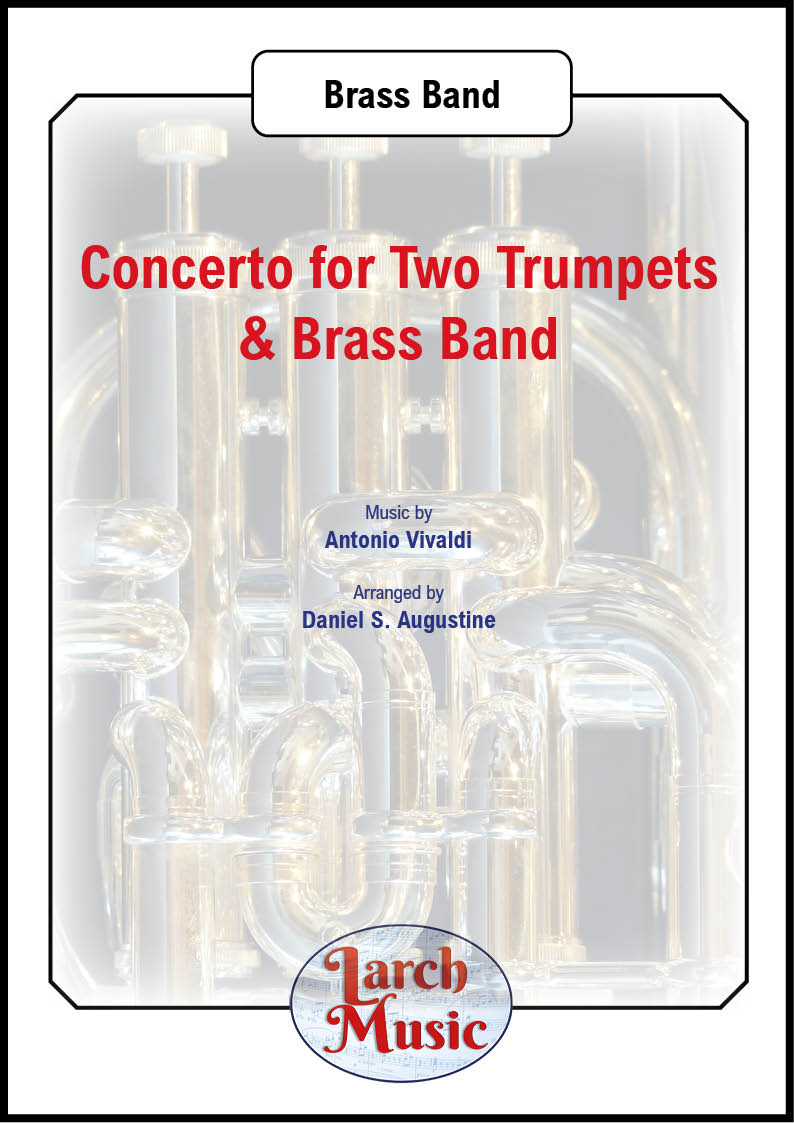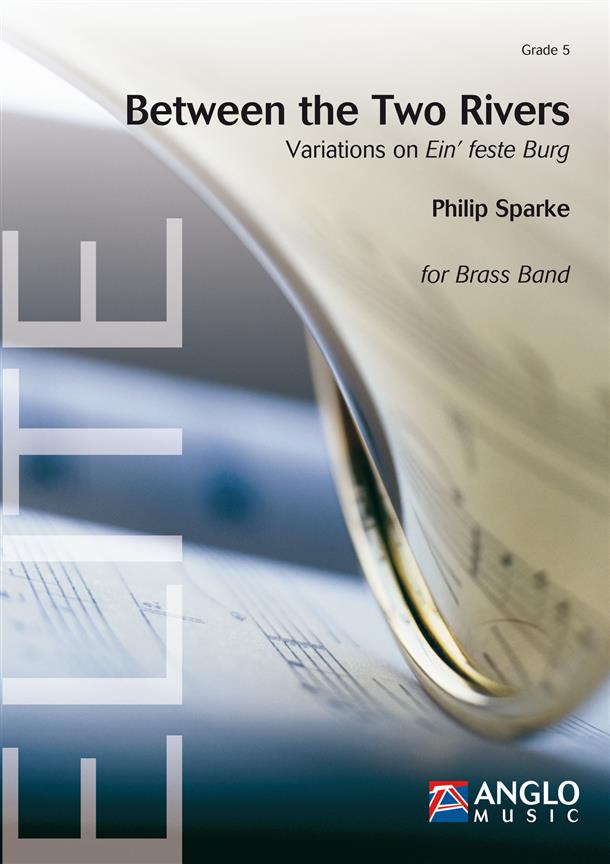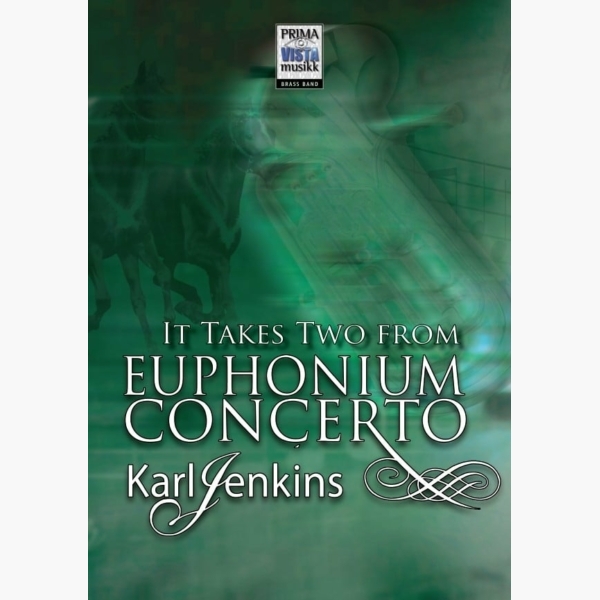Results
-
 £30.00
£30.00Concerto for Two Trumpets & Brass Band - Bb or Eb Duet & Brass Band Sheet Music Full Score & Parts- LM601
COMPOSER: Antonio VivaldiTRANSCRIBED : Daniel S. AugustineThe great duet from Vivaldi is now available for two players with brass band accompanimentThe soloists can be two Eb soprano cornets, 2 Bb Cornets or one of each.A chance to let your soloists shine with authentic backing transcribed from Vivaldi original score.Definitely one for your next concert.Concerto for Two Trumpets in C Major, double concerto for trumpets and strings byAntonio Vivaldi, one of the few solo works of the early 1700s to feature brass instruments. It is the only such piece by Vivaldi.The rarity of Vivaldi'sConcerto for Two Trumpetsstems from the difficulties inherent in the Baroque trumpet. At the time, trumpets were natural, or valveless. The instrument's range was quite restricted, and much depended on the performer's lip control, as with the modern bugle.As with the great majority of Vivaldi's concertos, this one begins with a quick and sparkling movement to catch the attention of the audience and to showcase the bright tones of the solo trumpets. This is followed by a languid and very brief second movement, with fanfare-like passages from the soloists overlaying sustained string tones. For the final movement, Vivaldi returned to brilliant mode with quick energy and intricate passages for the soloists.
In Stock: Estimated dispatch 3-5 working days
-
 £18.68
£18.68Christmas for Two - 70 Christmas Carols & Songs (Basic Set PDFs - Parts 1&2 US)
Bring the joy of the season to life with Christmas for Two - a unique collection of 70 well-loved Christmas carols and songs, expertly arranged by William Himes for two like (or similar) brass or woodwind instruments. Whether you're playing on the streets, in a church, or at a community event, these duets are perfect for spreading festive cheer with just two musicians. Inspired by a lifelong friendship and decades of caroling experience with The Salvation Army, revered composer William Himes has crafted accessible duet arrangements designed specifically for flexible instrumentation. After years of performing Christmas music in larger ensembles and later adapting those traditions into euphonium duets with his friend Mick, Himes realized the need for arrangements that sound full and satisfying without a full ensemble. As Himes explains, "Attempting to play duets using quartet books didn't work well because the most suitable alto harmony constantly shifted between the second and third part lines. We also discovered that our duets attracted as many Christmas donations as full ensembles!" Requiring average range and technique, the music is arranged in accessible keys also suitable for accompanying singing Available in Multiple Keys & Clefs - separate, easy-to-read march-size books for Part 1 and Part 2 in Bb, Eb, F, treble clef, and bass clef, in both international and U.S. sizes Perfect for Small Groups or Street Caroling - ideal for covering more donation sites or when a full ensemble isn't available Available as both PDF and print copy. Please note this product is a PDF download. Print copies are available here. Whether you're continuing a caroling tradition or starting a new one, Christmas for Two offers a joyful, practical way to make music together - and make a difference - during the festive season. Included in this set: Part 1 Bb Treble clef* Part 2 Bb Treble clef* *Two horns (Eb or F) can play these duets using Bb Part 1 and 2 books but should not attempt performance with other instruments at the same time. Books are also available for Part 2 in Eb and F, should an Eb or F player wish to play with a Bb player on Part 1. Bass clef books are also available in both parts. Both books in this download are US march card size (5" x 7" landscape).
In Stock: Estimated dispatch 1-3 working days
-
 £18.68
£18.68Christmas for Two - 70 Christmas Carols & Songs (Basic Set PDFs - Parts 1&2 A5)
Bring the joy of the season to life with Christmas for Two - a unique collection of 70 well-loved Christmas carols and songs, expertly arranged by William Himes for two like (or similar) brass or woodwind instruments. Whether you're playing on the streets, in a church, or at a community event, these duets are perfect for spreading festive cheer with just two musicians. Inspired by a lifelong friendship and decades of caroling experience with The Salvation Army, revered composer William Himes has crafted accessible duet arrangements designed specifically for flexible instrumentation. After years of performing Christmas music in larger ensembles and later adapting those traditions into euphonium duets with his friend Mick, Himes realized the need for arrangements that sound full and satisfying without a full ensemble. As Himes explains, "Attempting to play duets using quartet books didn't work well because the most suitable alto harmony constantly shifted between the second and third part lines. We also discovered that our duets attracted as many Christmas donations as full ensembles!" Requiring average range and technique, the music is arranged in accessible keys also suitable for accompanying singing Available in Multiple Keys & Clefs - separate, easy-to-read march-size books for Part 1 and Part 2 in Bb, Eb, F, treble clef, and bass clef, in both international and U.S. sizes Perfect for Small Groups or Street Caroling - ideal for covering more donation sites or when a full ensemble isn't available Available as both PDF and print copy. Please note this product is a PDF download. Print copies are also available from this website Whether you're continuing a caroling tradition or starting a new one, Christmas for Two offers a joyful, practical way to make music together - and make a difference - during the festive season. Included in this set: Part 1 Bb Treble clef* Part 2 Bb Treble clef* *Two horns (Eb or F) can play these duets using Bb Part 1 and 2 books but should not attempt performance with other instruments at the same time. Books are also available for Part 2 in Eb and F, should an Eb or F player wish to play with a Bb player on Part 1. Bass clef books are also available in both parts. Both books in this download are international A5 size.
In Stock: Estimated dispatch 1-3 working days
-
 £9.71
£9.71Christmas for Two - 70 Christmas Carols & Songs (arr. Himes) Print Copy -A5 size
Bring the joy of the season to life with Christmas for Two - a unique collection of 70 well-loved Christmas carols and songs, expertly arranged by William Himes for two like (or similar) brass or woodwind instruments. Whether you're playing on the streets, in a church, or at a community event, these duets are perfect for spreading festive cheer with just two musicians. Inspired by a lifelong friendship and decades of caroling experience with The Salvation Army, revered composer William Himes has crafted accessible duet arrangements designed specifically for flexible instrumentation. After years of performing Christmas music in larger ensembles and later adapting those traditions into euphonium duets with his friend Mick, Himes realized the need for arrangements that sound full and satisfying without a full ensemble. As Himes explains, "Attempting to play duets using quartet books didn't work well because the most suitable alto harmony constantly shifted between the second and third part lines. We also discovered that our duets attracted as many Christmas donations as full ensembles!" Requiring average range and technique, the music is arranged in accessible keys also suitable for accompanying singing Available in Multiple Keys & Clefs - separate, easy-to-read march-size books for Part 1 and Part 2 in Bb, Eb, F, treble clef, and bass clef, in both international and U.S. sizes Perfect for Small Groups or Street Caroling - ideal for covering more donation sites or when a full ensemble isn't available Available as both PDF and print copy. Please note this product is for print copy, international (A5) size and will be distributed from within the UK. Postage costs will apply accordingly. Whether you're continuing a caroling tradition or starting a new one, Christmas for Two offers a joyful, practical way to make music together - and make a difference - during the festive season. Available in this series: Part 1 Bb Treble clef* Part 1 Bass clef Part 2 Bb Treble clef* Part 2 Bass clef Part 2 Eb Treble clef* Part 2 F Treble clef* *Two horns (Eb or F) can play these duets using Bb Part 1 and 2 books but should not attempt performance with other instruments at the same time. All books in this print order are international A5 size.
In Stock: Estimated dispatch 1-3 working days
-
 £37.37
£37.37Christmas for Two - 70 Christmas Carols & Songs (Full Set PDFs - A5 size)
Bring the joy of the season to life with Christmas for Two - a unique collection of 70 well-loved Christmas carols and songs, expertly arranged by William Himes for two like (or similar) brass or woodwind instruments. Whether you're playing on the streets, in a church, or at a community event, these duets are perfect for spreading festive cheer with just two musicians. Inspired by a lifelong friendship and decades of caroling experience with The Salvation Army, revered composer William Himes has crafted accessible duet arrangements designed specifically for flexible instrumentation. After years of performing Christmas music in larger ensembles and later adapting those traditions into euphonium duets with his friend Mick, Himes realized the need for arrangements that sound full and satisfying without a full ensemble. As Himes explains, "Attempting to play duets using quartet books didn't work well because the most suitable alto harmony constantly shifted between the second and third part lines. We also discovered that our duets attracted as many Christmas donations as full ensembles!" Requiring average range and technique, the music is arranged in accessible keys also suitable for accompanying singing Available in Multiple Keys & Clefs - separate, easy-to-read march-size books for Part 1 and Part 2 in Bb, Eb, F, treble clef, and bass clef, in both international and U.S. sizes Perfect for Small Groups or Street Caroling - ideal for covering more donation sites or when a full ensemble isn't available Available as both PDF and print copy. Please note this product is a PDF download. Print copies are also available from this website Whether you're continuing a caroling tradition or starting a new one, Christmas for Two offers a joyful, practical way to make music together - and make a difference - during the festive season. Included in this set: Part 1 Bb Treble clef* Part 1 Bass clef Part 2 Bb Treble clef* Part 2 Bass clef Part 2 Eb Treble clef* Part 2 F Treble clef* *Two horns (Eb or F) can play these duets using Bb Part 1 and 2 books but should not attempt performance with other instruments at the same time.
In Stock: Estimated dispatch 1-3 working days
-
 £37.37
£37.37Christmas for Two - 70 Christmas Carols & Songs (Full Set PDFs - US size)
Bring the joy of the season to life with Christmas for Two - a unique collection of 70 well-loved Christmas carols and songs, expertly arranged by William Himes for two like (or similar) brass or woodwind instruments. Whether you're playing on the streets, in a church, or at a community event, these duets are perfect for spreading festive cheer with just two musicians. Inspired by a lifelong friendship and decades of caroling experience with The Salvation Army, revered composer William Himes has crafted accessible duet arrangements designed specifically for flexible instrumentation. After years of performing Christmas music in larger ensembles and later adapting those traditions into euphonium duets with his friend Mick, Himes realized the need for arrangements that sound full and satisfying without a full ensemble. As Himes explains, "Attempting to play duets using quartet books didn't work well because the most suitable alto harmony constantly shifted between the second and third part lines. We also discovered that our duets attracted as many Christmas donations as full ensembles!" Requiring average range and technique, the music is arranged in accessible keys also suitable for accompanying singing Available in Multiple Keys & Clefs - separate, easy-to-read march-size books for Part 1 and Part 2 in Bb, Eb, F, treble clef, and bass clef, in both international and U.S. sizes Perfect for Small Groups or Street Caroling - ideal for covering more donation sites or when a full ensemble isn't available Available as both PDF and print copy. Please note this product is a PDF download. Print copies are available here. Whether you're continuing a caroling tradition or starting a new one, Christmas for Two offers a joyful, practical way to make music together - and make a difference - during the festive season. Included in this set: Part 1 Bb Treble clef* Part 1 Bass clef Part 2 Bb Treble clef* Part 2 Bass clef Part 2 Eb Treble clef* Part 2 F Treble clef* *Two horns (Eb or F) can play these duets using Bb Part 1 and 2 books but should not attempt performance with other instruments at the same time. All books in this download are US march card size (5" x 7" landscape).
In Stock: Estimated dispatch 1-3 working days
-
Duet For Two Cats - G. Rossini - Len Jenkins
"Duet For Two Cats" is often performed as an encore to vocal recitals and operatic galas. It may be sung by two sopranos, male-female pairs, or even as a tomcat duet and can be accompanied by a piano or a full orchestra. The lyrics are simple; the single word 'Miaow', repeated with various styles of inflexion and attitude throughout the piece. Our arrangement is for a cornet and trombone. The piece is generally ascribed to Rossini, though there is some doubt as to its actual origins and whether it is an authentic work by that composer. It is believed that an English composer, Robert Lucas Pearsall under the pseudonym G. Berthold may have assembled the various elements from Rossini and perhaps other composers into the piece as we now know it. In order to achieve the correct balance between band and soloists, there is a need to mute most of the band instruments. Recognising that not all bands will have the larger mutes which are expensive and sometimes unwieldy, we suggest a form of muting made famous by a jazz trumpeter and which works well on most instruments. It consists of a circle of heat resistant padded table covering or felt, slightly larger than the bell diameter, with an elasticated edge like a 'mop-hat'. With 3 holes in it to let the sound out, the mute is then simply stretched over the bell to achieve the desired effect and folded up when not required.
-
 £152.99
£152.99Between the Two Rivers - Philip Sparke
Between the Two Rivers was commissioned by Fanfare 'Prins Hendrik', from Aalst in the Netherlands. The title derives from the fact that the town of Aalst lies between two tributaries of the River Dommel. The community is a highly religious one, so the famous Luther chorale, Ein' Feste Burg, was an obvious choice for Philip Sparke to use as the theme for this new work. It takes the form of a theme with four contrasting variations. Variation 1 is a moto perpetuo, variation 2 has a slower march like feel, variation 3 is a sinister slow movement and the final variation is in the form of a lyrical fugue. Between The Two Rivers is sure to become a major work inmodern brass band repertoire.
Estimated dispatch 5-14 working days
-
 £152.99
£152.99Between the Two Rivers (Brass Band - Score and Parts) - Sparke, Philip
Between the Two Rivers was commissioned by Fanfare Prins Hendrik, from Aalst in the Netherlands. The title derives from the fact that the town of Aalst lies between two tributaries of the River Dommel. The community is a highly religious one, so the famous Luther chorale, Ein' Feste Burg, was an obvious choice for Philip Sparke to use as the theme for this new work. It takes the form of a theme with four contrasting variations. Variation 1 is a moto perpetuo, variation 2 has a slower march like feel, variation 3 is a sinister slow movement and the final variation is in the form of a lyrical fugue. Between The Two Rivers is sure to become a major work in modern brass band repertoire.Duration: 15:00
Estimated dispatch 7-14 working days
-
 £34.95
£34.95"It Takes Two" from Euphonium Concerto - Karl Jenkins
It Takes Two is taken from Karl Jenkins' Euphonium Concerto, an extended work given its world premiere by euphonium soloist David Childs and the BBC Concert Orchestra conducted by Owain Arwel Hughes in St. David's Hall, Cardiff during the last...
Estimated dispatch 5-7 working days

